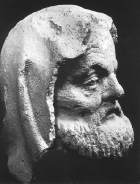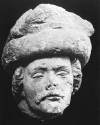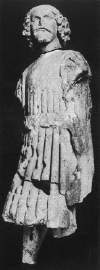

Statues were probably be used to fill hollows in the 15th century. This is why they have survived. Some of the statues are broken and unfinished, probably prepared for different buildings when the castle of Sigismund was built. The style of finds includes those of the Parler workshop and Czech masters. Lovely roundish faces of women and children, delicately portrayed men wearing drapes falling richly, and supple figures are characteristic of the statues. Figures of kings, knights in armour with delicate legs and shields with coats-of-arms were made to appear more lively as they were covered with paint. (Figures of armoured knights in draping mantles are related to fragments of the statue of a king in Nagyvárad holding a coat-of-arm with double cross in his left.)
 A group of statues in Buda which included a Madonna Statue and some figures in delicately folded mantles
A group of statues in Buda which included a Madonna Statue and some figures in delicately folded mantles was probably produced by a master of a workshop in Grosslobming in the 1410s. Strong fleshy young male heads are characteristic of the other group. Their masters may have worked in a workshop in Buda and accomplished the tomb of Stibor the Younger among others. There is only one fragment with a coat-of-arms indicating that the series was probably intended to decorate the palace of Sigismund in Buda.
was probably produced by a master of a workshop in Grosslobming in the 1410s. Strong fleshy young male heads are characteristic of the other group. Their masters may have worked in a workshop in Buda and accomplished the tomb of Stibor the Younger among others. There is only one fragment with a coat-of-arms indicating that the series was probably intended to decorate the palace of Sigismund in Buda.
Another set of statues including a delicately formed Madonna and dignified prophets and apostles in mantles richly folded was probably created by an artist from Western Europe. Figures wearing bright colours in times past, reflect realistic approaches of Claus Sluter, a sculptor from Brabant and amalgamate them with Gothic ideals. (Figures of knights are closely related to the wooden sculpture of St. Ladislaus of about 1430-40, Hungarian National Gallery.)